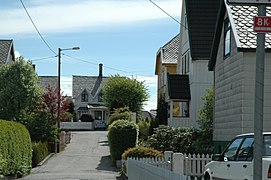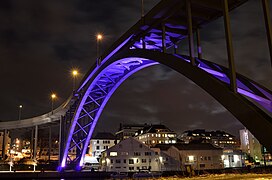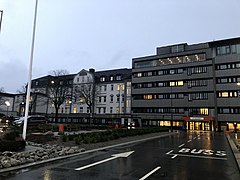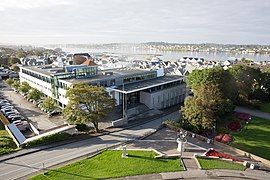Haugesund
Haugesund Municipality
Haugesund kommune | |
|---|---|
 View of Smedasundet and parts of central Haugesund | |
|
| |
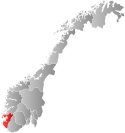 Rogaland within Norway | |
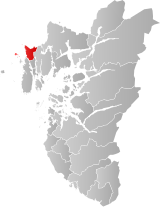 Haugesund within Rogaland | |
| Coordinates: 59°26′47″N 05°17′54″E / 59.44639°N 5.29833°E | |
| Country | Norway |
| County | Rogaland |
| District | Haugaland |
| Established | 1 Feb 1855 |
| • Preceded by | Torvastad Municipality |
| Administrative centre | Haugesund |
| Government | |
| • Mayor (2023) | Nils Konrad Bua (H) |
| Area | |
• Total | 72.69 km2 (28.07 sq mi) |
| • Land | 68.38 km2 (26.40 sq mi) |
| • Water | 4.31 km2 (1.66 sq mi) 5.9% |
| • Rank | #338 in Norway |
| Population (2023) | |
• Total | 37,855 |
| • Rank | #28 in Norway |
| • Density | 553.5/km2 (1,434/sq mi) |
| • Change (10 years) | |
| Demonyms | Haugesundar Haugesunder[1] |
| Official language | |
| • Norwegian form | Bokmål |
| Time zone | UTC+01:00 (CET) |
| • Summer (DST) | UTC+02:00 (CEST) |
| ISO 3166 code | NO-1106[3] |
| Website | Official website |
Haugesund ([ˈhæʉɡəsʉn] ⓘ) is a municipality and town on the North Sea in Rogaland county, Norway. As of December 2023, the municipality of Haugesund has a population of 37,855. The vast majority of the population (37,008) live in the Haugesund urban area in the municipality's southwest. The Haugesund urban area also extends into neighboring Karmøy municipality and has a combined population of 46,359.[4] Haugesund is the main commercial and economic centre of the Haugaland region in northern Rogaland and southern Vestland. The majority of the municipality outside this area is rural or undeveloped.[5]
The 72.68-square-kilometre (28.06 sq mi) municipality is the 338th largest by area out of the 356 municipalities in Norway. Haugesund is the 28th most populous municipality in Norway with a population of 37,855. The municipality's population density is 553.5 inhabitants per square kilometre (1,434/sq mi) and its population has increased by 5.9% over the previous 10-year period.[6][7]
The Haugesund urban area, which extends into the neighboring municipality of Karmøy, makes up about 15.5 square kilometres (6.0 sq mi) of the municipality. 8,884 people of the urban area live in Karmøy. Only about 1,000 residents of Haugesund municipality that live in the 57-square-kilometre (22 sq mi) rural portion of the municipality.[8]
Location
[edit]The town is situated on a strategically important sound, Karmsundet, through which ships could pass without traversing heavy seas. In the early years, the coastal waters off Haugesund were a huge source of herring, and the town grew accordingly. Despite being barely a village back then, King Harald Fairhair lived at Avaldsnes, very close to the modern town of Haugesund. In the last decades, the town, like its neighbours, has been turning towards the petroleum industry, with the herring being long gone.
During the last 20 years, the municipality has established its position as the main trading centre for the Haugaland region and southern parts of Vestland county. It has several relatively large shopping centres, however, this has led to a decline of the trade and shopping activity in the town centre.[9]
The Haugesund Region, a statistical metropolitan area, which consists of the municipalities Karmøy, Haugesund, Tysvær, Sveio and Bokn, has a population of approximately 100,000 people (as of 2009).
History
[edit]

Despite being a fairly young town, the areas surrounding Haugesund were lands of power during the Viking Age. Harald Fairhair was the first king of Norway. He had his home in Avaldsnes, also known as Homeland of the Viking Kings, only 8 km (4.9 mi) from the present town.[10][11] After his death in c. 940, it is believed Fairhair was buried at Haraldshaugen, a burial mound adjacent to the Karmsundet strait.[12] This site is the namesake of the town and municipality of Haugesund. The national monument at Haraldshaugen was raised in 1872, to commemorate the 1000th anniversary of the Battle of Hafrsfjord in 872. The Battle of Hafrsfjord has traditionally been regarded as when western Norway was unified under a single monarch for the first time.[13]

Haugesund has a strong historical bond to the sea and especially the herring. In the earlier years, the coastal waters of Haugesund were a huge source for fishing herring, and the town grew accordingly. The protective straits of Smedasund and Karmsund gave the town potential to grow in both fishing and shipping. Even to this day, Karmsund is one of Norway's busiest waterways. The town is still growing geographically even though the population has increased only moderately the last decade. In modern times the herring are depleted and the town is turning towards the petroleum industry, like its neighbouring town to the south, Stavanger.
Municipal history
[edit]The urban village area of Haugesund (population: 1,066) was declared to be a "town" and it was separated from the surrounding municipality of Torvastad on 1 February 1855 to become a separate municipality of its own. On 1 January 1911, a small urban area of Skåre (population: 3,847) that directly abutted the town of Haugesund was transferred to Haugesund. On 1 January 1958, the remainder of the municipality of Skåre was merged with the town of Haugesund, creating a larger Haugesund municipality. On 1 January 1965, the island of Vibrandsøy (population: 70) was transferred from Torvastad municipality to Haugesund.[14]
Etymology
[edit]The municipality (and the town) is named after the Haugesundet strait (Old Norse: Haugasund), which is named after the old Hauge farm (Old Norse: Haugar). The first element is the plural genitive case of haugr which means "hill" or "mound". The last element is sund which means "strait" or "sound".[5][15]
Coat of arms
[edit]

The original coat of arms was granted on 29 December 1862 and it was in use until 5 March 1930 when a new coat of arms was approved. The arms were designed as a painting of a harbour scene. The old arms showed three full herring barrels sitting on land and an anchor leaning against the barrels. In the background, the ocean harbour is showing along with three seagulls flying in the sky. Often, it was shown with a gold mural crown above the shield. The old arms showed the importance of herring fishing and processing in the town. The three barrels also represented the three parts of the municipality: the mainland and the islands of Hasseløy and Risøy. The arms were designed by A. Fenger Krog.[16][17]
A new coat of arms was granted on 5 March 1930 to replace the old arms and to simplify them for the celebration of the 75th anniversary of the town. The blazon is "Azure, three seagulls volant argent per fess surmounted by a mural crown Or" (Norwegian: I blått tre flyvnde sølv måker). This means the arms have a blue field (background) and the charge is a set of three seagulls lined up vertically. The charge has a tincture of argent which means it is commonly colored white, but if it is made out of metal, then silver is used. The seagulls and blue color were chosen to represent the importance of the sea. The new arms from 1930 removed the herring barrels from the old arms due to the decline in the importance of that industry. The arms were designed by Hallvard Trætteberg. The municipal flag has the same design as the coat of arms.[16][17]
Geography and climate
[edit]
Haugesund municipality has a coastline with the North Sea, however, the island of Karmøy and the archipelago of Røvær shelter it from the rough waters of the ocean. The Karmsundet strait, located between Karmøy and Haugesund used to be very strategically important, since ships could pass without having to sail through heavy sea. Haugesund's city centre has a distinctive street layout, similar to those found in Kristiansand and Oslo. The municipality includes several islands. Risøy and Hasseløy are densely built, and connected to the mainland by bridges. Røvær which lies further out and consists of a number of islands, is also populated and connected to the mainland by ferry. Vibrandsøy and its neighboring islands are now mainly a recreational area. Røværsholmen Lighthouse sits just off the coast of the main Røvær island. The lakes Vigdarvatnet and Stakkastadvatnet are located in the municipality.
Haugesund has an oceanic climate (Cfb, marine west coast) with rainy winters and mild and pleasant summers. The all-time high 31.2 °C (88.2 °F) was recorded July 2019, and the all-time low −16.6 °C (2.1 °F) was set in January 2010 (extremes since 2003). The wettest time of year is autumn and winter, while April–July is the driest season. Haugesund Airport is situated in Karmøy municipality, about 8 kilometres (5.0 mi) from the town of Haugesund, and it has been recording weather data since 1975.
| Climate data for Haugesund Airport Karmøy 1991-2020 (24 m, precipitation Haugesund-Rossabø, extremes 2003–2020) | |||||||||||||
|---|---|---|---|---|---|---|---|---|---|---|---|---|---|
| Month | Jan | Feb | Mar | Apr | May | Jun | Jul | Aug | Sep | Oct | Nov | Dec | Year |
| Record high °C (°F) | 10.2 (50.4) |
11.5 (52.7) |
16.9 (62.4) |
20.8 (69.4) |
30.8 (87.4) |
29.4 (84.9) |
31.2 (88.2) |
29.6 (85.3) |
29.3 (84.7) |
20.2 (68.4) |
15.9 (60.6) |
11.6 (52.9) |
31.2 (88.2) |
| Mean daily maximum °C (°F) | 4 (39) |
4 (39) |
6 (43) |
10 (50) |
13 (55) |
15 (59) |
18 (64) |
18 (64) |
15 (59) |
12 (54) |
8 (46) |
6 (43) |
11 (51) |
| Daily mean °C (°F) | 3 (37) |
2.1 (35.8) |
3.3 (37.9) |
6.3 (43.3) |
9.4 (48.9) |
12 (54) |
14.9 (58.8) |
15.2 (59.4) |
12.9 (55.2) |
8.8 (47.8) |
5.9 (42.6) |
3.6 (38.5) |
8.1 (46.6) |
| Mean daily minimum °C (°F) | 1 (34) |
0 (32) |
1 (34) |
4 (39) |
7 (45) |
10 (50) |
13 (55) |
13 (55) |
11 (52) |
7 (45) |
4 (39) |
2 (36) |
6 (43) |
| Record low °C (°F) | −16.6 (2.1) |
−13 (9) |
−13.3 (8.1) |
−5.9 (21.4) |
−2.2 (28.0) |
1.6 (34.9) |
5.6 (42.1) |
4.9 (40.8) |
1.1 (34.0) |
−3.4 (25.9) |
−11.4 (11.5) |
−14.9 (5.2) |
−16.6 (2.1) |
| Average precipitation mm (inches) | 160 (6.3) |
133 (5.2) |
123 (4.8) |
86 (3.4) |
76 (3.0) |
85 (3.3) |
97 (3.8) |
143 (5.6) |
172 (6.8) |
197 (7.8) |
199 (7.8) |
192 (7.6) |
1,663 (65.4) |
| Source 1: yr.no/met.no/eklima[18] | |||||||||||||
| Source 2: Weatheronline (avg highs/lows 1996-2020) [19] | |||||||||||||
Cityscape
[edit]-
Common street in Haugesund
-
Haugesund harbour
-
Risøybrua seen from Risøy
-
Haugesund hospital
-
Campus Haugesund
Haugesund City Hall was built in 1931, celebrating its 75th anniversary in 2006.[20] The pink city hall, designed by Gudolf Blakstad and Herman Munthe-Kaas,[21] is one of the finest neo-classical buildings in Norway, and has been elected the most beautiful building in Haugesund.[22] It is also included in the new Norwegian edition of the game Monopoly after it was successful in a national vote. The building may not be altered in any way without permission from the national preservation agency. It overlooks the town square and a park which was inaugurated on 28 August 1949.[22]
During the last 20 years, the municipality has established its position as the main trading centre for the Haugaland region and southern parts of Vestland county. It has several relatively large shopping centres, however, this has led to a decline of the trade and shopping activity in the town centre.[9]
There are several churches in the town of Haugesund including Vår Frelsers Church, Udland Church, Rossabø Church, and Skåre Church.
Government
[edit]Haugesund Municipality is responsible for primary education (through 10th grade), outpatient health services, senior citizen services, welfare and other social services, zoning, economic development, and municipal roads and utilities. The municipality is governed by a municipal council of directly elected representatives. The mayor is indirectly elected by a vote of the municipal council.[23] The municipality is under the jurisdiction of the Haugaland og Sunnhordland District Court and the Gulating Court of Appeal.
Municipal council
[edit]The municipal council (Kommunestyre) of Haugesund is made up of 49 representatives that are elected every four years. The government is located at the Haugesund City Hall. The tables below show the current and historical composition of the council by political party
| Party name (in Norwegian) | Number of representatives | |
|---|---|---|
| Labour Party (Arbeiderpartiet) | 11 | |
| Progress Party (Fremskrittspartiet) | 7 | |
| Green Party (Miljøpartiet De Grønne) | 1 | |
| Conservative Party (Høyre) | 15 | |
| Industry and Business Party (Industri‑ og Næringspartiet) | 3 | |
| Christian Democratic Party (Kristelig Folkeparti) | 2 | |
| Pensioners' Party (Pensjonistpartiet) | 2 | |
| Red Party (Rødt) | 1 | |
| Centre Party (Senterpartiet) | 1 | |
| Socialist Left Party (Sosialistisk Venstreparti) | 4 | |
| Liberal Party (Venstre) | 2 | |
| Total number of members: | 49 | |
| Party name (in Norwegian) | Number of representatives | |
|---|---|---|
| Labour Party (Arbeiderpartiet) | 15 | |
| Progress Party (Fremskrittspartiet) | 6 | |
| Green Party (Miljøpartiet De Grønne) | 3 | |
| Conservative Party (Høyre) | 14 | |
| Christian Democratic Party (Kristelig Folkeparti) | 2 | |
| Pensioners' Party (Pensjonistpartiet) | 2 | |
| Red Party (Rødt) | 1 | |
| Centre Party (Senterpartiet) | 2 | |
| Socialist Left Party (Sosialistisk Venstreparti) | 3 | |
| Liberal Party (Venstre) | 1 | |
| Total number of members: | 49 | |
| Party name (in Norwegian) | Number of representatives | |
|---|---|---|
| Labour Party (Arbeiderpartiet) | 19 | |
| Progress Party (Fremskrittspartiet) | 7 | |
| Green Party (Miljøpartiet De Grønne) | 2 | |
| Conservative Party (Høyre) | 11 | |
| Christian Democratic Party (Kristelig Folkeparti) | 3 | |
| Pensioners' Party (Pensjonistpartiet) | 2 | |
| Centre Party (Senterpartiet) | 1 | |
| Socialist Left Party (Sosialistisk Venstreparti) | 2 | |
| Liberal Party (Venstre) | 2 | |
| Total number of members: | 49 | |
| Party name (in Norwegian) | Number of representatives | |
|---|---|---|
| Labour Party (Arbeiderpartiet) | 14 | |
| Progress Party (Fremskrittspartiet) | 6 | |
| Conservative Party (Høyre) | 19 | |
| Christian Democratic Party (Kristelig Folkeparti) | 3 | |
| Pensioners' Party (Pensjonistpartiet) | 3 | |
| Socialist Left Party (Sosialistisk Venstreparti) | 1 | |
| Liberal Party (Venstre) | 3 | |
| Total number of members: | 49 | |
| Party name (in Norwegian) | Number of representatives | |
|---|---|---|
| Labour Party (Arbeiderpartiet) | 10 | |
| Progress Party (Fremskrittspartiet) | 7 | |
| Conservative Party (Høyre) | 20 | |
| Christian Democratic Party (Kristelig Folkeparti) | 3 | |
| Pensioners' Party (Pensjonistpartiet) | 2 | |
| Socialist Left Party (Sosialistisk Venstreparti) | 2 | |
| Liberal Party (Venstre) | 5 | |
| Total number of members: | 49 | |
| Party name (in Norwegian) | Number of representatives | |
|---|---|---|
| Labour Party (Arbeiderpartiet) | 12 | |
| Progress Party (Fremskrittspartiet) | 12 | |
| Conservative Party (Høyre) | 14 | |
| Christian Democratic Party (Kristelig Folkeparti) | 3 | |
| Pensioners' Party (Pensjonistpartiet) | 1 | |
| Centre Party (Senterpartiet) | 1 | |
| Socialist Left Party (Sosialistisk Venstreparti) | 4 | |
| Liberal Party (Venstre) | 2 | |
| Total number of members: | 49 | |
| Party name (in Norwegian) | Number of representatives | |
|---|---|---|
| Labour Party (Arbeiderpartiet) | 12 | |
| Progress Party (Fremskrittspartiet) | 10 | |
| Conservative Party (Høyre) | 15 | |
| Christian Democratic Party (Kristelig Folkeparti) | 6 | |
| Socialist Left Party (Sosialistisk Venstreparti) | 3 | |
| Liberal Party (Venstre) | 3 | |
| Total number of members: | 49 | |
| Party name (in Norwegian) | Number of representatives | |
|---|---|---|
| Labour Party (Arbeiderpartiet) | 12 | |
| Progress Party (Fremskrittspartiet) | 9 | |
| Conservative Party (Høyre) | 11 | |
| Christian Democratic Party (Kristelig Folkeparti) | 6 | |
| Pensioners' Party (Pensjonistpartiet) | 2 | |
| Centre Party (Senterpartiet) | 1 | |
| Socialist Left Party (Sosialistisk Venstreparti) | 2 | |
| Liberal Party (Venstre) | 6 | |
| Total number of members: | 49 | |
| Party name (in Norwegian) | Number of representatives | |
|---|---|---|
| Labour Party (Arbeiderpartiet) | 15 | |
| Progress Party (Fremskrittspartiet) | 7 | |
| Conservative Party (Høyre) | 13 | |
| Christian Democratic Party (Kristelig Folkeparti) | 11 | |
| Pensioners' Party (Pensjonistpartiet) | 12 | |
| Centre Party (Senterpartiet) | 2 | |
| Socialist Left Party (Sosialistisk Venstreparti) | 5 | |
| Liberal Party (Venstre) | 4 | |
| Total number of members: | 69 | |
| Party name (in Norwegian) | Number of representatives | |
|---|---|---|
| Labour Party (Arbeiderpartiet) | 22 | |
| Progress Party (Fremskrittspartiet) | 11 | |
| Conservative Party (Høyre) | 18 | |
| Christian Democratic Party (Kristelig Folkeparti) | 10 | |
| Socialist Left Party (Sosialistisk Venstreparti) | 2 | |
| Liberal Party (Venstre) | 6 | |
| Total number of members: | 69 | |
| Party name (in Norwegian) | Number of representatives | |
|---|---|---|
| Labour Party (Arbeiderpartiet) | 25 | |
| Progress Party (Fremskrittspartiet) | 7 | |
| Conservative Party (Høyre) | 21 | |
| Christian Democratic Party (Kristelig Folkeparti) | 10 | |
| Centre Party (Senterpartiet) | 1 | |
| Socialist Left Party (Sosialistisk Venstreparti) | 2 | |
| Liberal Party (Venstre) | 3 | |
| Total number of members: | 69 | |
| Party name (in Norwegian) | Number of representatives | |
|---|---|---|
| Labour Party (Arbeiderpartiet) | 22 | |
| Progress Party (Fremskrittspartiet) | 4 | |
| Conservative Party (Høyre) | 26 | |
| Christian Democratic Party (Kristelig Folkeparti) | 11 | |
| New People's Party (Nye Folkepartiet) | 1 | |
| Centre Party (Senterpartiet) | 1 | |
| Socialist Left Party (Sosialistisk Venstreparti) | 1 | |
| Liberal Party (Venstre) | 3 | |
| Total number of members: | 69 | |
| Party name (in Norwegian) | Number of representatives | |
|---|---|---|
| Labour Party (Arbeiderpartiet) | 25 | |
| Anders Lange's Party (Anders Langes parti) | 4 | |
| Conservative Party (Høyre) | 16 | |
| Christian Democratic Party (Kristelig Folkeparti) | 12 | |
| New People's Party (Nye Folkepartiet) | 6 | |
| Centre Party (Senterpartiet) | 2 | |
| Socialist Left Party (Sosialistisk Venstreparti) | 2 | |
| Liberal Party (Venstre) | 2 | |
| Total number of members: | 69 | |
| Party name (in Norwegian) | Number of representatives | |
|---|---|---|
| Labour Party (Arbeiderpartiet) | 25 | |
| Conservative Party (Høyre) | 16 | |
| Christian Democratic Party (Kristelig Folkeparti) | 10 | |
| Centre Party (Senterpartiet) | 3 | |
| Socialist People's Party (Sosialistisk Folkeparti) | 2 | |
| Liberal Party (Venstre) | 13 | |
| Total number of members: | 69 | |
| Party name (in Norwegian) | Number of representatives | |
|---|---|---|
| Labour Party (Arbeiderpartiet) | 26 | |
| Conservative Party (Høyre) | 17 | |
| Christian Democratic Party (Kristelig Folkeparti) | 8 | |
| Centre Party (Senterpartiet) | 1 | |
| Socialist People's Party (Sosialistisk Folkeparti) | 2 | |
| Liberal Party (Venstre) | 15 | |
| Total number of members: | 69 | |
| Party name (in Norwegian) | Number of representatives | |
|---|---|---|
| Labour Party (Arbeiderpartiet) | 29 | |
| Conservative Party (Høyre) | 18 | |
| Christian Democratic Party (Kristelig Folkeparti) | 7 | |
| Centre Party (Senterpartiet) | 1 | |
| Liberal Party (Venstre) | 14 | |
| Total number of members: | 69 | |
| Party name (in Norwegian) | Number of representatives | |
|---|---|---|
| Labour Party (Arbeiderpartiet) | 26 | |
| Conservative Party (Høyre) | 17 | |
| Christian Democratic Party (Kristelig Folkeparti) | 7 | |
| Centre Party (Senterpartiet) | 1 | |
| Liberal Party (Venstre) | 18 | |
| Total number of members: | 69 | |
| Party name (in Norwegian) | Number of representatives | |
|---|---|---|
| Labour Party (Arbeiderpartiet) | 24 | |
| Conservative Party (Høyre) | 16 | |
| Christian Democratic Party (Kristelig Folkeparti) | 7 | |
| Liberal Party (Venstre) | 14 | |
| Total number of members: | 61 | |
| Party name (in Norwegian) | Number of representatives | |
|---|---|---|
| Labour Party (Arbeiderpartiet) | 22 | |
| Conservative Party (Høyre) | 14 | |
| Communist Party (Kommunistiske Parti) | 1 | |
| Christian Democratic Party (Kristelig Folkeparti) | 7 | |
| Liberal Party (Venstre) | 16 | |
| Total number of members: | 60 | |
| Party name (in Norwegian) | Number of representatives | |
|---|---|---|
| Labour Party (Arbeiderpartiet) | 21 | |
| Conservative Party (Høyre) | 14 | |
| Communist Party (Kommunistiske Parti) | 2 | |
| Christian Democratic Party (Kristelig Folkeparti) | 5 | |
| Liberal Party (Venstre) | 18 | |
| Total number of members: | 60 | |
| Party name (in Norwegian) | Number of representatives | |
|---|---|---|
| Labour Party (Arbeiderpartiet) | 25 | |
| Conservative Party (Høyre) | 13 | |
| Communist Party (Kommunistiske Parti) | 4 | |
| Liberal Party (Venstre) | 18 | |
| Total number of members: | 60 | |
| Party name (in Norwegian) | Number of representatives | |
|---|---|---|
| Labour Party (Arbeiderpartiet) | 21 | |
| Conservative Party (Høyre) | 21 | |
| Liberal Party (Venstre) | 18 | |
| Total number of members: | 60 | |
| Note: Due to the German occupation of Norway during World War II, no elections were held for new municipal councils until after the war ended in 1945. | ||
Mayors
[edit]The mayors (Norwegian: ordfører) of Haugesund:[44]
- 1855–1856: Tønnes Eide
- 1857–1858: Gudmund Halleland
- 1859–1860: Peder A. Høydahl
- 1861–1866: Ludolf J. Eide
- 1867–1867: Østen Kolstø
- 1868–1868: Ditlev Møller
- 1869–1871: E. M. Fredriksen
- 1872–1872: Jens H. Hansen
- 1873–1874: Ludolf J. Eide
- 1875–1876: Arne Lothe
- 1877–1877: Ludolf J. Eide
- 1878–1878: Jens H. Hansen
- 1879–1879: Hans J. Steensnæs
- 1880–1880: Arne Lothe
- 1881–1881: Ludolf J. Eide
- 1882–1882: Jens H. Hansen
- 1883–1883: Hans J. Steensnæs (V)
- 1884–1884: Jens H. Hansen (V)
- 1885–1885: Hans J. Steensnæs (MV)
- 1886–1886: Hans J. Kyvik
- 1887–1887: J. Ferdinand Jacobsen
- 1888–1888: Jacob Kielland
- 1889–1889: Frithjof Eide (V)
- 1890–1890: Hans J. Steensnæs (MV)
- 1891–1891: Svend Jacobsen (MV)
- 1892–1892: Johan Aubert
- 1893–1893: Svend Jacobsen (MV)
- 1894–1895: Hakon Magne Wrangell (MV)
- 1896–1896: Hans Steen (MV/H)
- 1897–1897: Hakon Magne Wrangell (MV)
- 1898–1898: Hans Steen (MV/H)
- 1899–1899:Hakon Magne Wrangell (MV)
- 1900–1900: Thomas Haaland (MV)
- 1901–1901: Erich Lindøe (MV)
- 1902–1903: Thomas Haaland (MV)
- 1904–1904: Rasmus G. Hagland (V)
- 1905–1907: Ola Bertelsen (V)
- 1908–1908: Svend Lindøe (AvH)
- 1909–1909: Valentin Valentinsen (V)
- 1910–1910: Thomas Haaland (LL)
- 1911–1911: Magne Rønnevig (V)
- 1912–1912: Carl J. Dueland (Ap)
- 1913–1913: Bernt Seland (V)
- 1914–1914: Svend Lindøe (AvH)
- 1915–1916: Valentin Valentinsen (V)
- 1917–1917: Lars O. Meling (V)
- 1918–1918: Kristian Holgersen (V)
- 1919–1919: Carl J. Westerlund (Ap)
- 1920–1921: Peder Haugen (FV)
- 1922–1922: Carl J. Westerlund (Ap)
- 1923–1924: Gabriel Faye (FV)
- 1925–1925: Christian Haaland (H)
- 1926–1926: Clement Gerhardsen (FV)
- 1927–1927: Edvard Velde (NSA)
- 1928–1931: Christian Haaland (H)
- 1932–1935: H. Karluf Hanssen (V)
- 1936–1936: Søren Caspersen (Ap)
- 1937–1937: Martin Olaussen (Ap)
- 1938–1938: Ingvald Førre (Ap)
- 1939–1940: Sigurd Lie (H)
- 1941–1941: Eystein Jenssen (LL)
- 1942–1945: Jacob Kyvik (NS)
- 1945–1945: Hans Jacobsen (NS)
- 1945–1945: Sigurd Lie (H)
- 1946–1947: Nils E. Nilsen (Ap)
- 1948–1949: Einar Osland (V)
- 1950–1950: Karl Sørensen (V)
- 1951–1951: Andreas Gullhaugen (Ap)
- 1952–1952: Karl Sørensen (V)
- 1953–1953: Rasmus Bakkevig (H)
- 1954–1954: Karl Sørensen (V)
- 1955–1955: Gunnar Fredrik Hellesen (H)
- 1956–1957: Karl Sørensen (V)
- 1958–1959: Gunnar Fredrik Hellesen (H)
- 1960–1961: Karl Sørensen (V)
- 1962–1963: Stener Askeland (H)
- 1964–1965: Jens Edvard Haugland (V)
- 1966–1967: Stener Askeland (H)
- 1968–1969: Jens Edvard Haugland (V)
- 1970–1971: Olle Johan Eriksen (H)
- 1972–1973: Jens Edvard Haugland (V)
- 1974–1975: Olle Johan Eriksen (H)
- 1976–1977: Ola Foldøy (KrF)
- 1978–1983: Olle Johan Eriksen (H)
- 1984–1987: Edvard Ringen, Jr. (H)
- 1988–1989: Einar Steensnæs (KrF)
- 1990–1991: Nils J. Storesund (Ap)
- 1992–1993: Einar Steensnæs (KrF)
- 1993–1995: Turid Dalland (H)
- 1995–2001: Finn Martin Vallersnes (H)
- 2001–2015: Petter Steen Jr. (H)
- 2015–2023: Arne-Christian Mohn (Ap)
- 2023-present: Nils Konrad Bua (H)[45]
Transport
[edit]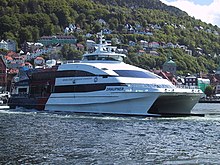
Haugesund Airport, located on the island of Karmøy to the southwest of Haugesund in Karmøy municipality, has year-round flights to Oslo and Gdańsk in addition to some seasonal and charter destinations.[46] The Norwegian airline Coast Air was based at Haugesund airport, but filed for bankruptcy on 23 January 2008.[47]
The European Route E39 bypasses Haugesund to the east, passing through Aksdal. The European Route E134 leads eastwards to Drammen outside Oslo.
The bus station in Haugesund is located at Flotmyr on the east side of the downtown area. Long-distance bus services are available to Stavanger, Bergen, and Oslo. The local bus transport is operated by Vy Buss, on a contract with Kolumbus.
The town is connected to the island of Utsira by car ferry, and to the islands of Røvær and Feøy by passenger ferry. Until 2008, the Newcastle–Bergen–Stavanger ferry operated here as well.
Healthcare
[edit]Haugesund Hospital provides specialist health services to around 180,000 inhabitants in North Rogaland, Sunnhordland, Hardanger and Ryfylke. The hospital offers services in both medicine and surgery, radiology / X-ray, childbirth / maternity, gynecology and fertility, habilitation and specialized treatment in mental health care.[48] There are also more than 10 public and private health centers in the municipality for either general or specialized care, including the Privatsykehuset Haugesund.
Culture
[edit]Haugesund is the main cultural centre for its region, and is home to several festivals, the largest being the Norwegian International Film Festival and Sildajazz, an international jazz festival with approximately 70 bands and close to 200 concerts. Every August, The Norwegian Trad-jazz festival, the Sildajazz is held. Both local and international musicians are presented at the Sildajazz.[49]
In the summer of 2004, the annual rock festival, ""RockFest"" started. It attracted local, national and international pop and rock bands, such as Elton John, Madcon, DumDum Boys and Kaizers Orchestra. The festival started as a part of the celebration of Haugesund's 150 year anniversary. In 2009, the last Rockfest was held, and got replaced by a new concept in 2010; Haugesund Live. Haugesund Live is a series of individual concerts, and has featured bands such as the Baseballs, Kim Larsen and Mötley Crüe.
The Norwegian International Film Festival has since 1973 been held in Haugesund, premiering and showing international and Norwegian films. The Amanda Award, Norway's variation of the Oscars, has been held in Haugesund since 1985 [50] in concurrence with the film festival.
Haugesunds Avis is a daily newspaper published in Haugesund, but with branches in Bømlo, Kopervik, Odda, Sauda and Stord. Founded in 1895, it is today owned by the investment group Mecom Group, and is as such part of the media group Edda Media. In 2006, Haugesunds Avis had a circulation of 33 448.[51] The newspaper owns the local radio channel Radio 102.
Churches
[edit]The Church of Norway has three parishes (sokn) within the municipality of Haugesund. It is part of the Haugaland prosti (deanery) in the Diocese of Stavanger.
| Parish (sokn) | Church name | Location of the church | Year built |
|---|---|---|---|
| Rossabø | Rossabø Church | Rossabø | 1972 |
| Skåre | Skåre Church | Haugesund | 1858 |
| Udland Church | Haugesund | 2002 | |
| Vår Frelser | Vår Frelsers Church | Haugesund | 1901 |
Education
[edit]The main campus of Stord/Haugesund University College is located in Haugesund. Established in 1994, it is the result of the merger between Haugesund Nursing College, Stord Teachers College, and Stord Nursing College.[52] The university college has approximately 2700 students and 260 employees,[52] thus making it one of the smallest university colleges in Norway.
The county of Rogaland operates four high schools in Haugesund. The schools Skeisvang and Vardafjell prepare pupils for further for college or university studies. The schools Haugaland and Karmsund are vocational high schools. In addition, the private Haugesund Toppidrettsgymnas has a sports-oriented high school program.
The municipality has seven pure elementary schools of grades 1 to 7 (Saltveit, Gard, Austrheim, Solvang, Lillesund, Rossabø, and Brakahaug), two pure middle schools of grades 8 to 10 (Haraldsvang and Håvåsen) and three grade 1 to 10 schools (Hauge, Røvær, and Skåredalen). In addition, the Breidablik school offers elementary and middle school courses to new foreigners and refugees. The two private schools are Steinerskolen offering a Waldorf education program, and Danielsen, a Christian school offering courses for grades 8 and 9.[53]
Sports
[edit]Football (soccer)
[edit]The strongest local football team is FK Haugesund that has stayed in the Norwegian Premier League since 2010. The team plays its home matches at Haugesund Stadion.
Other local football teams are Vard Haugesund, Djerv 1919 and SK Haugar.
Other sports
[edit]- Haugesund IL, athletics.
- Haugesund Seagulls, ice hockey
- Haugesund Turnforening, gymnastics
International relations
[edit]Twin towns – sister cities
[edit]Haugesund has sister city agreements with the following places:
 Ekenäs, Uusimaa, Finland[54]
Ekenäs, Uusimaa, Finland[54] Emden, Lower Saxony, Germany[54]
Emden, Lower Saxony, Germany[54] Søllerød, Hovedstaden, Denmark[54]
Søllerød, Hovedstaden, Denmark[54] Ystad, Skåne, Sweden[54]
Ystad, Skåne, Sweden[54]
Each of the sister cities (with exception of Emden) has given its name to a street in Haugesund. The streets are located in the same area near the border to the neighbouring municipality.[55]
Notable people
[edit]
- Hanna Brummenæs (1860-1942), a pioneering female shipping company owner and City Councillor[56]
- Eivind Nielsen (1864–1939), a painter and illustrator of children's books
- Egil Eide (1868–1946), a silent film actor and director[57]
- Henrik Børseth (1885–1970), an actor[58]
- Ellen Sinding (1899–1980), an actress and dancer[59]
- Tollak B. Sirnes (1922–2009), a physician, psychiatrist, and pharmacologist
- Olle Johan Eriksen (1923–1999), a politician who was mayor of Haugesund in the 1970s
- Odd Langholm (born 1928), an economist and historian of economic thought
- Jacob Stolt-Nielsen (1931–2015), an entrepreneur who founded Stolt-Nielsen, a parcel tanker firm
- Hanne Krogh (born 1956), a singer and actress, won the Eurovision Song Contest 1985[60]
- Jon Fosse (born 1959), an author and dramatist[61]
- Turid Birkeland (1962–2015), a cultural executive and former politician
- Steffen Kverneland (born 1963), an illustrator and comics writer
- Kjetil Steensnæs (born 1976), a jazz musician who plays guitar, dobro, and banjo
- Captain Frodo (born 1976), a Guinness World Record breaking contortionist who lives in Australia
- Gunhild Stordalen (born 1979), a physician and environmental advocate
- Susanne Sundfør (born 1986), a singer-songwriter and record producer[62]
US emigrants
[edit]- Gunvald Aus (1851–1950), an engineer who built the Woolworth Building in New York City
- Hannah Kallem (1865-1937), an American Army nurse who served in the Spanish–American War
- Martin Edward Mortensen (1897–1981), the son of an emigrant from the village of Skjold near Haugesund, was listed as father on Monroe's birth certificate. A statue of Marilyn Monroe by Nils Aas stands in the harbour of Haugesund.[63]
- Sigmund R. Petersen (born ca.1940), a rear admiral and fourth Director of the NOAA Commissioned Officer Corps, who emigrated in 1948 to the USA
Sport
[edit]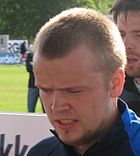
- Stig Traavik (born 1967), a former judoka at 1992 Summer Olympics and diplomat.
- Egil Østenstad (born 1972), a former footballer with 334 club caps and 18 for Norway
- Trygve Nygaard (born 1975), a retired footballer with over 300 club caps
- Kenneth Høie (born 1979), a former football goalkeeper with 330 club caps
- Svein Oddvar Moen (born 1979), a Norwegian football referee
- Susanne Wigene (born 1978), a middle and long-distance runner
- Christian Grindheim (born 1983), a retired footballer with 530 club caps and 54 for Norway
- Tor Arne Andreassen (born 1983), former footballer, played 334 games with FK Haugesund
- Alexander Søderlund (born 1987), a footballer with over 300 club caps and 32 for Norway
- Sven Erik Bystrøm (born 1992), a Norwegian road bicycle racer
- Tommy Langaker (born 1994), a Brazilian Jiu Jitsu athlete, first Norwegian Black Belt World Champion under IBJJF
See also
[edit]References
[edit]- ^ "Navn på steder og personer: Innbyggjarnamn" (in Norwegian). Språkrådet.
- ^ "Forskrift om målvedtak i kommunar og fylkeskommunar" (in Norwegian). Lovdata.no.
- ^ Bolstad, Erik; Thorsnæs, Geir, eds. (9 January 2024). "Kommunenummer". Store norske leksikon (in Norwegian). Foreningen Store norske leksikon.
- ^ Tettsteders befolkning og areal, Statistics Norway (12 December 2023)
- ^ a b Thorsnæs, Geir, ed. (13 August 2017). "Haugesund". Store norske leksikon (in Norwegian). Kunnskapsforlaget. Retrieved 1 November 2017.
- ^ Statistisk sentralbyrå. "Table: 06913: Population 1 January and population changes during the calendar year (M)" (in Norwegian).
- ^ Statistisk sentralbyrå. "09280: Area of land and fresh water (km²) (M)" (in Norwegian).
- ^ sentralbyrå, Statistisk (1 January 2014). "Urban settlements. Population and area, by municipality".
- ^ a b Ballo, Jannike Gottschalk (29 June 2010). "Flytter ut av sentrum" (in Norwegian). Haugesunds avis. Retrieved 14 June 2013.
- ^ "Exploring Haugesund, homeland of the Viking Kings". CRUISE TO TRAVEL. 24 July 2019. Retrieved 28 September 2020.
- ^ "Visit Haugesund - homeland of the viking kings". Haugesund & Haugalandet AS. Retrieved 28 September 2020.
- ^ "Harald I | Biography & Facts". Encyclopedia Britannica. Retrieved 28 September 2020.
- ^ "Haraldshaugen monument to the founder of Norway in Haugesund (Stavanger Travel AS)". stavangertravel.com. Retrieved 24 December 2015.
- ^ Jukvam, Dag (1999). Historisk oversikt over endringer i kommune- og fylkesinndelingen (PDF) (in Norwegian). Statistisk sentralbyrå. ISBN 9788253746845.
- ^ Rygh, Oluf (1915). Norske gaardnavne: Stavanger amt (in Norwegian) (10 ed.). Kristiania, Norge: W. C. Fabritius & sønners bogtrikkeri. p. 419.
- ^ a b "Civic heraldry of Norway - Norske Kommunevåpen". Heraldry of the World. Retrieved 1 July 2023.
- ^ a b "Haugesund, Rogaland (Norway)". Flags of the World. Retrieved 1 July 2023.
- ^ "climate statistics Haugesund Airport Karmøy".
- ^ "Weatheronline climate robot". Retrieved 24 November 2021.
- ^ Pedersen, Idar H. (2006). "Haugesund Rådhus" (in Norwegian). Haugesund kommune. Archived from the original on 9 October 2007. Retrieved 24 October 2007.
- ^ Pedersen, Idar H. (2007). "Den italienske drømmen" (in Norwegian). Retrieved 24 October 2007. [dead link]
- ^ a b "The City Hall in Haugesund" (PDF) (in Norwegian). Haugesund kommune. Retrieved 24 October 2007.[dead link]
- ^ Hansen, Tore; Vabo, Signy Irene, eds. (20 September 2022). "kommunestyre". Store norske leksikon (in Norwegian). Kunnskapsforlaget. Retrieved 14 October 2022.
- ^ "Kommunestyrevalg 2023 - Rogaland". Valgdirektoratet. Retrieved 25 January 2024.
- ^ "Kommunestyrevalg 2019 – Rogaland". Valgdirektoratet. Retrieved 2 July 2020.
- ^ "BYSTYRET" (in Norwegian). Haugesund kommune. 14 October 2015. Retrieved 30 April 2017.
- ^ a b c d "Table: 04813: Members of the local councils, by party/electoral list at the Municipal Council election (M)" (in Norwegian). Statistics Norway.
- ^ "Kommunestyrevalg 2011 – Rogaland". Valgdirektoratet. Retrieved 2 July 2020.
- ^ "Kommunestyrevalget 1995" (PDF) (in Norwegian). Oslo-Kongsvinger: Statistisk sentralbyrå. 1996. Retrieved 2 July 2020.
- ^ "Kommunestyrevalget 1991" (PDF) (in Norwegian). Oslo-Kongsvinger: Statistisk sentralbyrå. 1993. Retrieved 2 July 2020.
- ^ "Kommunestyrevalget 1987" (PDF) (in Norwegian). Oslo-Kongsvinger: Statistisk sentralbyrå. 1988. Retrieved 2 July 2020.
- ^ "Kommunestyrevalget 1983" (PDF) (in Norwegian). Oslo-Kongsvinger: Statistisk sentralbyrå. 1984. Retrieved 2 July 2020.
- ^ "Kommunestyrevalget 1979" (PDF) (in Norwegian). Oslo: Statistisk sentralbyrå. 1979. Retrieved 2 July 2020.
- ^ "Kommunevalgene 1975" (PDF) (in Norwegian). Oslo: Statistisk sentralbyrå. 1977. Retrieved 2 July 2020.
- ^ "Kommunevalgene 1972" (PDF) (in Norwegian). Oslo: Statistisk sentralbyrå. 1973. Retrieved 2 July 2020.
- ^ "Kommunevalgene 1967" (PDF) (in Norwegian). Oslo: Statistisk sentralbyrå. 1967. Retrieved 2 July 2020.
- ^ "Kommunevalgene 1963" (PDF) (in Norwegian). Oslo: Statistisk sentralbyrå. 1964. Retrieved 2 July 2020.
- ^ "Kommunevalgene og Ordførervalgene 1959" (PDF) (in Norwegian). Oslo: Statistisk sentralbyrå. 1960. Retrieved 2 July 2020.
- ^ "Kommunevalgene og Ordførervalgene 1955" (PDF) (in Norwegian). Oslo: Statistisk sentralbyrå. 1957. Retrieved 2 July 2020.
- ^ "Kommunevalgene og Ordførervalgene 1951" (PDF) (in Norwegian). Oslo: Statistisk sentralbyrå. 1952. Retrieved 2 July 2020.
- ^ "Kommunevalgene og Ordførervalgene 1947" (PDF) (in Norwegian). Oslo: Statistisk sentralbyrå. 1948. Retrieved 2 July 2020.
- ^ "Kommunevalgene og Ordførervalgene 1945" (PDF) (in Norwegian). Oslo: Statistisk sentralbyrå. 1947. Retrieved 2 July 2020.
- ^ "Kommunevalgene og Ordførervalgene 1937" (PDF) (in Norwegian). Oslo: Statistisk sentralbyrå. 1938. Retrieved 2 July 2020.
- ^ Pedersen, Idar H. "Ordfører". Haugesund kommune (in Norwegian). Archived from the original on 17 August 2016. Retrieved 1 July 2023.
- ^ "Nils Konrad Bua blir ny ordfører i Haugesund". NRK (in Norwegian). 13 September 2023. Retrieved 25 January 2024.
- ^ "Avinor entry for Haugesund Airport". Archived from the original on 19 September 2015. Retrieved 20 November 2017.
- ^ "Bankruptcy grounds Coast Air - Aftenposten.no". Archived from the original on 24 January 2008. Retrieved 24 January 2008.
- ^ Haugesund sjukehus. "Haugesund sjukehus". Helse Fonna. Retrieved 3 August 2020.
- ^ "Sildajazz" (in Norwegian). Retrieved 18 May 2017.
- ^ Furuly, Jan Gunnar (16 August 2014). "Haugesund: - Filmfestivalen er vår, fingrene av fatet Stavanger". Aftenposten (in Norwegian). Retrieved 18 May 2017.
- ^ "Avisenes leser- og opplagstall for 2006" (in Norwegian). Mediebedriftenes Landsforening. 2007. Archived from the original on 27 April 2007. Retrieved 26 October 2007.
- ^ a b "Om HSH" (in Norwegian). Høgskolen Stord/Haugesund. 2007. Retrieved 24 October 2007.
- ^ "GRUNNSKOLER". Retrieved 28 December 2020.
- ^ a b c d Pedersen, Idar H. (2004). "Vennskapsbyer" (in Norwegian). Haugesund kommune. Archived from the original on 9 October 2007. Retrieved 25 October 2007.
- ^ "Map of Norway". 1881.no. Retrieved 12 October 2015.
- ^ Norheim, Steinar (26 March 2015). "Brummenæs & Torgersen - Europas første kvinnelige skipsredere" (in Norwegian). Archived from the original on 27 March 2023. Retrieved 4 August 2023.
- ^ Egil Eide at IMDb. Retrieved 03 April 2021.
- ^ Henrik Børseth at IMDb. Retrieved 03 April 2021.
- ^ Ellen Sinding at IMDb Retrieved 04 April 2021.
- ^ Hanne Krogh at IMDb Retrieved 03 April 2021.
- ^ Jon Fosse at IMDb. Retrieved 03 April 2021.
- ^ Susanne Sundfør at IMDb Retrieved 03 April 2021.
- ^ "Birth of Marilyn Monroe Shown to Be Legitimate". The New York Times. 13 February 1981. Retrieved 1 December 2016.
External links
[edit]- Municipal fact sheet from Statistics Norway (in Norwegian)
 Haugesund travel guide from Wikivoyage
Haugesund travel guide from Wikivoyage- . Encyclopædia Britannica. Vol. 13 (11th ed.). 1911.
- Tourist information (English, German and Norwegian language)
- Municipality website (Norwegian language)
- Haugalandet.net
- Haraldshaugen, the national monument




